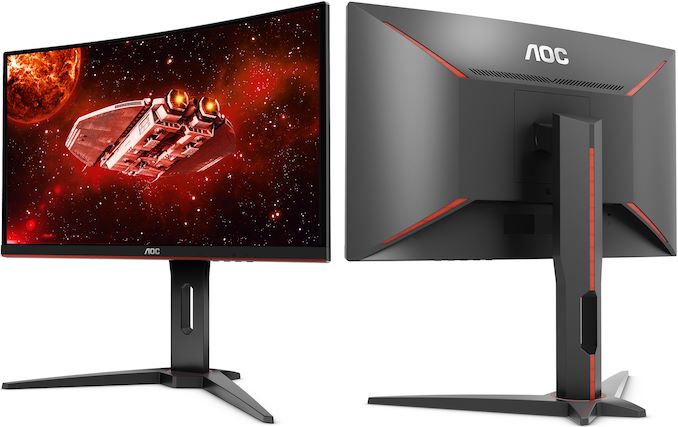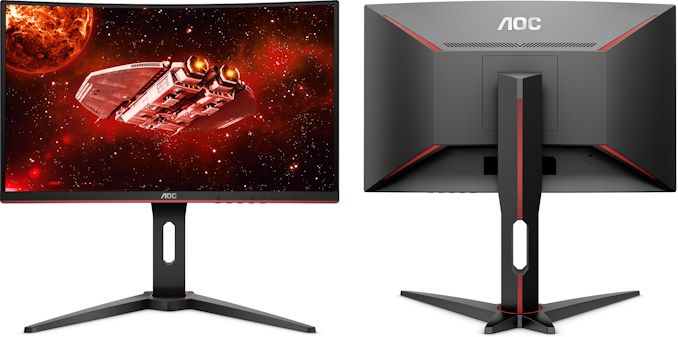AOC Launches CQ27G1 Curved Monitor: 27 Inch, 144 Hz, FreeSync, Sub-$300
by Anton Shilov on September 3, 2019 10:30 AM EST
AOC has expanded its lineup of inexpensive G1-series curved displays with a new model. The new 27-inch CQ27G1 features a QHD resolution as well as G1’s traditional set of features, including a 144 Hz maximum refresh rate, AMD’s FreeSync technology, and a 1800R curvature.
The AOC CQ27G1 is based on a 27-inch curved VA panel featuring a 2560×1440 resolution, 250-nits peak brightness, a 3000:1 contrast ratio, 178/178º viewing angles, 1 ms MPRT response times, and a 144 Hz refresh rate. In line with other inexpensive VA panels on the market, this one can display 16.7 million colors.
AOC’s CQ27G1 monitor will sit between the Full-HD C27G1 of the same size and the larger QHD C32G1. Just like other members of the family, this one features three key technologies important for gamers, including AMD’s FreeSync dynamic refresh rate technology, a 144 Hz maximum refresh rate, and 1 ms ultra-low motion picture response time. AOC has not revealed the FreeSync ranges of the display and whether they are wide enough to support AMD’s Low Frame Rate (LFC) features. Typically, entry-level 144 Hz monitors offer rather decent FreeSync ranges from 30 to 144 Hz, yet LFC capability is not guaranteed.
When it comes to connectivity, the CQ27G1 keeps the number of ports to a minimum, it only features a DisplayPort 1.2, two HDMI 2.0 inputs, as well as a 3.5-mm headphone jack. To keep BOM costs in check, neither of AOC’s G1 monitors are equipped with speakers, or a USB hub. Meanwhile, the CQ27G1 features a decent stand that can adjust height (±130 mm), tilt (-4° ~ +21.5°), and swivel (±34°). Furthermore, the display has 100x100 VESA mounting holes.
| AOC's 27-Inch G1 QHD Monitor | |
| CQ27G1 | |
| Panel | 27" IPS |
| Native Resolution | 2560 × 1440 |
| Maximum Refresh Rate | 144 Hz |
| Response Time | 1 ms MPRT |
| Brightness | 250 cd/m² |
| Contrast | 3000:1 |
| Viewing Angles | 178°/178° horizontal/vertical |
| Curvature | 1800R |
| Pixel Pitch | 0.2335 mm² |
| Pixel Density | 109 ppi |
| Anti-Glare Coating | ? |
| Color Gamut | sRGB |
| Dynamic Refresh Rate | AMD FreeSync (30 - 144 Hz?) |
| Inputs | 1 × DP 1.2 2 × HDMI 2.0 |
| USB Hub | none |
| Audio | audio out port |
| Power Consumption | Idle: 0.5 W Typical: 29 W |
| Stand | Tilt: -4° ~ +21.5° Swivel: ±34° Height: ±130 mm |
| Launch Price | $279.99 |
AOC’s CQ27G1 curved display is now available from Amazon and other leading retailers for $279.99.
Related Reading
- AOC Unveils Cheap G1-Series Curved Displays with 144 Hz & FreeSync: Starting at $28
- AOC’s CQ32G1 Curved Monitor: 31.5 Inch, 144 Hz, FreeSync, Sub $400
- AOC’s Agon Monitors with 0.5ms Response Time & 240 Hz Refresh Now Available
- AOC Introduces Its G2868PQU Monitor: An Inexpensive 4K Gaming Display with FreeSync
Source: AOC













20 Comments
View All Comments
samerakhras - Tuesday, September 3, 2019 - link
250 cd/m² is too low for today standards. at least 400 is acceptable todaySirMaster - Tuesday, September 3, 2019 - link
Really? I run my monitor at about 150 cd/m2. Anything more and it just hurts my eyes after awhile.rscsr90 - Tuesday, September 3, 2019 - link
I'm the same. I always run my monitors at minimum.Unless you really have shining the sun directly on the monitor you usually don't need much.
DanNeely - Tuesday, September 3, 2019 - link
Agreed; it depends on how bright your area is; mine're generally at 100. >200 is only really needed for outdoor usage (where you generally want at least 500 for use in direct sunlight) or HDR (where current standards are baselining at 1000 for LCD; but for which up to ~10k would be useful for very small/bright sunlight reflections).250 vs 300 is only relevant in that the latter's backlight has a bit more room to decline before becoming too dim. OTOH at that point you're talking about a decade+ old display; at which point it's just one of many possible failure modes.
jabber - Tuesday, September 3, 2019 - link
Yeah my monitors usually sit at 55-60% brightness.crimsonson - Tuesday, September 3, 2019 - link
1000 HDR does not mean the entire monitor or even the average brightness is 1000. It just means that the brightest section should not exceed 1000 nits.1000 nits is actually very bright. A 27" monitor at 1000 nits is as bright as 75W bulb.
Even 600 nits is extremely bright in a "dim living room".
When grading for HDR with 1000 nits level, you want the image to be generally between 60 - 300 nits. White titles are often recommended to be 200-250 nits.
Obviously, if you are outdoors or the overall environment is very bright (offfice with large windows), 300+ nits may be more suitable. But a typical bedroom or living room or home office, 100-200 nits is often the typical brightness level for computer monitors.
Vitor - Tuesday, September 3, 2019 - link
For indoor it works just fine.FreckledTrout - Tuesday, September 3, 2019 - link
I suppose if you are wearing sunglasses while using your PC then 250 cd/m² wouldn't be enough brightness. Seriously if you really have experience with these brightness levels and this is the case you should see an optometrist because your scotopic vision is horrible to the point you may have some type of eye disease.crimsonson - Tuesday, September 3, 2019 - link
That is kind of arbitrary comment. You need to put some context in that number or it means nothing at all. 100, 120, 400, 600, 1000 cd/m are all meaningless without context.PeachNCream - Tuesday, September 3, 2019 - link
I kind of agree with the general consensus of others that run displays at sub 150 cd/m2 levels. Even in a well lit room, its easier on my eyes to keep the brightness lowered. Short being in direct sunlight, I don't think there's anything wrong with 250 cd/m2.